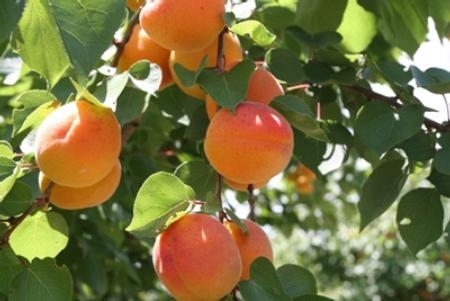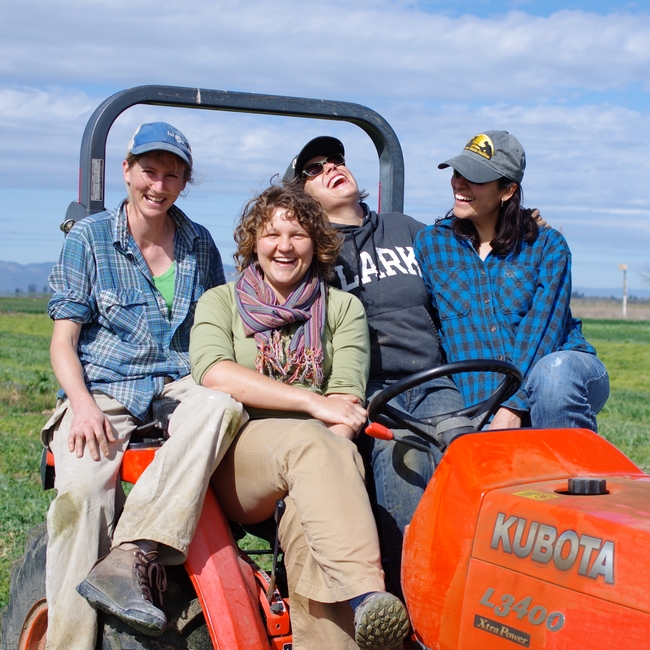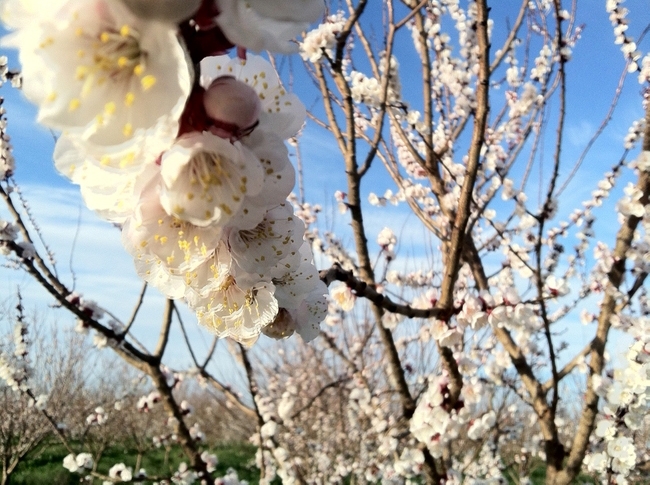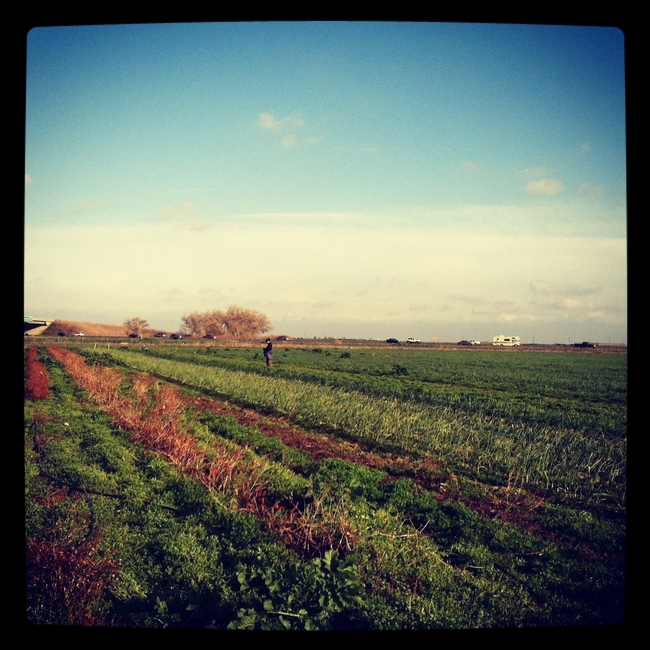Posts Tagged: apricots
Arrival of apricot season
The brief season of apricot harvest is upon us, and many fruit enthusiasts will soon bite into one of these small, delicate, yellowish-orange fruits. I grew up in a San Jose subdivision that was built on an apricot orchard. Each house had 2 or 3 apricot trees left on the lot, and so I have great memories of enjoying them fresh from the tree, still warm from the sun and tartly sweet . But, I have to admit that my favorite form of apricot then and now, are home-dried apricots. They sure were a great treat to find nestled in my trusty red-plaid metal lunchbox in the middle of winter.
Apricots have been grown in the fertile crescent of Persia for thousands of years. The colonists brought the apricot to North America, but most of the stock of today’s production comes from seedlings carried by the Franciscan friars who built the missions and brought much of Spain’s agriculture to California.
In recent years I have heard many disappointed comments at that first bite of a fresh apricot, and I was curious to check with University of California pomologists and USDA Agricultural Research Station specialists to see what progress was being made in bringing more flavorful apricots to consumers. Five different pomologists indicated that market produce buyers tend to primarily value color, size and firmness over the flavor of apricots. The earlier the produce buyers can get them into the grocery store, the more highly they are valued, so they are often harvested before the fruit’s flavor has a chance to develop. The experts I checked with all said they NEVER bought apricots anywhere except a farmer’s market or roadside stand.
The varieties most commonly grown in California are “Patterson”, “Tilton” and “Apache,” and they are selected by growers because of their early harvest dates, large size, attractive color, longer shelf life, and their ability to be used for either fresh or canning applications. Tom Gradziel, a UC Davis professor of genetics and breeding of the Prunus species said, “In the Central Valley, most apricots are still going for processing. Therefore a dual market (processing or fresh) variety such as Patterson is often preferred. It has excellent color, size, and firmness, but tastes like cardboard."
The varieties that the pomologists included in their list of favorites are “Royal Blenheim,” “Robada,” “Katy,” “Primarosa” and “Derby.” Craig Ledbetter, a geneticist working with apricot breeding at the Parlier USDA Agricultural Research Service Center said, “We hear so much about flavor, but I don’t think flavor will be coming to the grocery stores unless in the form of overripe fruit. Here we breed for a sugar/acid balance. We have many breeding selections that taste absolutely fabulous, but are a bit smaller than growers desire. Honestly, they don’t even want to look at ‘small’ fruit. It is a pity!”
Selecting apricots. Apricots do not develop more flavor after they are picked, so select fruit that are completely yellow, deepening toward orange. The subtle, sweet scent of apricot is a good indicator that the inside will taste just as good.
Storing apricots. Keep them on the counter if you will eat them within 2 to 3 days, otherwise store ripe apricots in the refrigerator in a perforated plastic bag.
How to enjoy apricots. Apricots have a pit in the center that is easily separated from the flesh. After washing the fruit, cut in half along the seam and remove the pit. Enjoy the whole fruit, or prepare in tarts, breads, jams, glazes for meats, salsa, or dry them in a dehydrator.
Apricot Tart
Pastry.
1 ¼ c. all-purpose flour
½ tsp. salt
1 Tbls. granulated sugar
½ tsp. almond flavoring (optional)
½ c. unsalted butter, chilled
2 Tbls. Ice water
Using a pastry blender, stir together flour, salt and sugar, cut in butter until dough is in coarse crumbs. Cut in water until pastry holds together when pinched, do not over mix. Lay out a sheet of plastic wrap, form pastry into a ball and wrap with the plastic wrap. Refrigerate 60 minutes. Remove plastic wrap and place on lightly floured surface, roll out to a 12” – 14” circle. Place on a baking tray lined with parchment paper, and return to the refrigerator while preparing the apricot filling.
Apricot filling.
½ c. granulated sugar (or less if the apricots are sweet)
1 Tbls. cornstarch
Dash of salt
1 ½ lbs. (or 10 medium-large) fresh, ripe apricots, pitted and sliced into 1/4” slices
Place sugar, cornstarch and salt into a bowl and stir well, add sliced apricots and toss gently.
Remove pastry from the refrigerator, place apricot filling in the center of the pastry, leaving a 2” border around the edge. Gently fold the pastry border up on top of the apricots, folding the pastry up around the outside edges of the fruit and pinching folds to form a round tart. Seal any cracks in the sides and bottom of the pastry so the juice doesn’t leak out on the baking sheet. Leave the fruit showing in the center of the pastry. Sprinkle with a handful of sliced almonds if desired.
Bake at 375 degrees F for 40-45 minutes, or until golden brown.
Excellent served with vanilla ice cream.
University of California Resources:
- Recommendations for Maintaining Postharvest Quality of Apricots
- Storing Fresh Fruits and Vegetables for Better Taste
- Apricot Information: Fruit & Nut Research and Information Center
The promise of peaches
Tomatoes grow fine in my Sacramento backyard. I can usually count on plenty of basil, more zucchini than the neighbors will take, some snow peas, chard and kale, a few small peppers and eggplants and whatever salad greens survive the slugs (in other words, lots of arugula). We have oranges and grapefruit, but I wouldn't even try to grow peaches or apricots. It takes a farmer to grow peaches. It takes a good farmer to grow good peaches. It takes a good farmer and good weather to grow Blenheim apricots.
Instead of planting a peach tree, I joined a fruit community supported agriculture (CSA) program, promising to pay $15 a week for a box of fresh fruit every week from June 7 until October 4. By joining I am agreeing to share the risk and the promise of the harvest of a four-acre fruit orchard with four part-time beginning farmers growing fruits and vegetables just west of Davis.
Emma Torbet and Sasha Klein started growing vegetables as The Cloverleaf at Bridgeway Farms about two years ago. Rich Collins, land-owner and sponsor of The Cloverleaf, planted the fruit trees four years ago but doesn't have the time to manage the orchard, so he leased it to the Cloverleaf farmers this year. Aubrey White and Marisa Alcorta joined as farm partners also this year. Together, the four women work long hours on weekends and evenings to farm an acre and a half of vegetables and the four acres of peaches, apricots, nectarines and figs. Like most beginning farmers, all four work full-time at other jobs; Torbet at the Russell Ranch Sustainable Agriculture Facility, Klein with the Farmer Veteran Coalition, White with the UC Agricultural Sustainability Institute, and Alcorta with the National Center for Appropriate Technology.
The Cloverleaf at Bridgeway Farms offers a chance that is, Aubrey White says, "both attractive and terrifying, with everyone trying to make it happen while keeping their jobs." The monetary investments were low, as they have no buildings or heavy equipment, and Collins offered a very attractive lease arrangement to encourage the new farmers. The vegetable land is certified organic and the orchard land is in transition to organic. The part that is terrifying is the risk of crop failure and poor yields that all farmers face.
The Cloverleaf farmers all have some farming experience, but the orchard presented new challenges. White started with the UC Master Gardener Program in Los Angeles, worked with urban farms and community gardens, and for two years at the UC Davis Student Farm. But, she says, taking on the orchard involved a "crazy different learning curve for three out of four of us." Even with all of her agricultural experience, she felt at a disadvantage not having a science background, particularly not having the soil science information to best manage the orchard.
Luckily, the new farmers found a mentor. Organic farmer Carl Rosato, owner of Woodleaf Farm near Oroville, is the soil scientist peach farmer that every beginning orchard manager would love to know. Rosato has taken on advising the Cloverleaf farmers as they learn to confront peach leaf curl and blossom rot by keeping the soil healthy and pruning the trees to ensure good air ventilation. Knowing that Rosato is involved gives me hope that we'll see some Blenheim apricots in the CSA box this June.
The original point of CSA programs was for the community (eaters) to share the risk of farming with the farmers, and to pay for a season's worth of produce up front to ease the cash-flow burden on the farmer before the harvest. In a pure traditional CSA, the farmer estimates the production for the year and sells shares in that production to as many families as the farm can be expected to feed. Each family receives a box of produce every week, with the full week's harvest divided up among the boxes. Some weeks there would be more variety than others; bounty and low yield would all be shared. Some years there would be good harvests and some years, poor harvests. The farmers are not at the mercy of the market, either wholesale buyers or competitive farmers' markets.
Most California CSA operators do not follow this traditional model, but sell to wholesale customers, restaurants, farmers markets and food processors in addition to the CSA customers. This means, in practice, that CSA customers do not share the full risk of the farm production and can expect a more consistent quantity in their box or basket each week. However, CSAs are an important and valuable part of most CSA operators' marketing plan. A UC study of several California organic farms selling through different marketing channels showed that the CSAs consistently returned the most profit to the marketing investment.
As a small farm with a young orchard, The Cloverleaf's fruit CSA still involves a little risk to the members. If the rain continues through June, as it did last year, we may not get those delicious Blenheims. Last year everyone lost them. But CSA manager White promises to give first priority to the CSA customers, with 25 to 50 percent of the fruit harvest going to CSA members. If needed, Cloverleaf will buy more blackberries from Collins or fill the boxes with the more successful varieties of peaches and nectarines.
In addition to the CSA, The Cloverleaf farmers will operate a farm stand, several U-pick days and a harvest festival this year, and sell fruit to several wholesale buyers. Just in case they don't have enough to do, they are considering introducing pastured chickens to the farm next year. The farm stand will open on Memorial Day at the Kidwell Road exit off Highway 80 between Davis and Dixon, and will remain open on Saturdays and Sundays until October. Information about the U-pick days and the harvest festival (and lots of other on-farm activities throughout California) will be listed on the UC Agritourism Directory, www.calagtour.org.
There might be a few shares left for the fruit CSA. For more information, visit the website or Facebook page of The Cloverleaf at Bridgeway Farms or email thecloverleaffarm@gmail.com. I'm looking forward to those peaches!
Master Gardener shares rare fruit source with Chron readers
A Master Gardener with UC Cooperative Extension in Santa Clara County, Laramie Treviño, turned San Francisco Chronicle readers on to a source of fast-producing, unusual fruit trees in a feature story printed over the weekend.
Treviño profiled C. Todd Kennedy and Patrick Schafer, rare fruit enthusiasts who run their online-only nursery as a "personal charity," the story said. Tree prices are $19.50, low considering they are already a good size and most will produce fruit within one year.
Kennedy and Schafer have constructed an unusual business model for Arboreum.biz.
- Two dozen varieties are offered each year, and then those types are unavailable for a few years thereafter
- Only enough inventory is propagated to ensure that its stock sells out
- The company has no catalogs, no printed growing tips, no listed fax or telephone numbers
- Surplus fruit trees will be available at Filoli Garden Center when the estate reopens Feb. 9. Filoli is a historic country estate about 30 miles south of San Francisco that is open to the public.
- 'Mericrest' nectarine
- 'Turkey' apricot
- 'Silver Logan' peach
- 'Howard's Miracle' plum
Arboreum.biz wasn't working for me this morning. Perhaps the additional traffic generated by the San Francisco Chronicle article was too much for the Web site.





